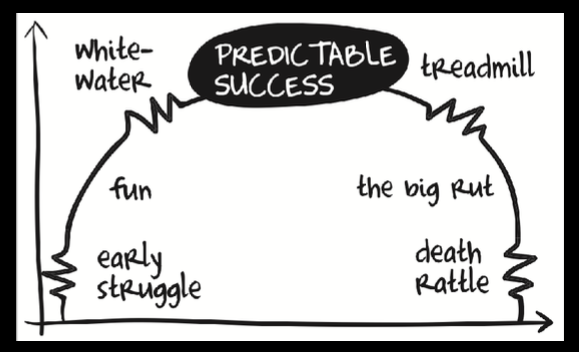This post contains everything you need to know about how to go from an entrepreneur to a CEO. There may be some of you that never want to have CEO in your job title, but the true purpose of this post is to give you the do’s and don’t’s of how to drastically grow your business.
If you’ve ever tried to go out on your own with contract work or your own business, you know this is what it feels like:

It’s terrifying. There’s a tsunami at your back and you don’t control the velocity or force. You’re in survival mode, dumping out heaps of water bursting through the ship’s cracks all by yourself; trying not sink to and stay afloat. You’re responsible for getting your employees safely home to their families, you’re trying to make your own family happy, and of course, you’ve gotta make sure the customers are happy too.
Unfortunately, this miserable juggle is completely normal in the first season of going out on your own, but for your own sanity, you CANNOT stay there! It’s not sustainable for you or your business. No matter if you’ve been in this season before or if you’re there now, I hope you’ll be able to glean something from these common mistakes entrepreneurs make.
Six Reasons Entrepreneurs Stay Stuck
1. They Don’t Think Sales First
People are scared to think sales first. They want to perfect their product and brand, and believe everything needs to be perfect before they can start selling. The thing is, you have to create revenue to go to the next base camp. You need money to conduct research in order to perfect your product and brand.
I think the best way to think sales first is to take a look at your sales funnel. What I mean by that is, focus on the pathway that leads a prospect from initial interest to checkout. Is it an obvious, easy path? Is there fabulous customer service along the way? Can I put customers on another path to keep them coming back?
If you’ve got money falling out of the sky because your sales funnel is working, then inevitable criticism a young business will face will hurt your pride and reputation way less.
2. They Try To Do Too Much
I’ve said this before, and I’ll say it again, but automation trumps determination. If you’re an entrepreneur, I’m going to assume you feel spread thin, and here is my advice. You need to automate everything you can! You are only you, and you do not have the capacity to do it all. You are going to run out of time. Create email automations, create delivery automations and automate everything you can.

Get Your FREE Copy of Dotcom Secrets Today!
Additionally, you also may be trying to do too much with your product, but you don’t have to be all things to all people. In fact, the best products are the ones that focus on a specific population and one bleeding neck pain. I hope that takes some weight off your shoulders and gives you freedom to be a scalpel. It exists to do one thing and one thing only. If your customer avatar has three bleeding neck pains, don’t try to heal them all. Focus on one and master it.
3. They’ve Never Identified the Life Cycle of Business and Where They Are In It
Have you ever heard anyone say work on your business, not in your business? Sometimes, we’re so close to our business that we can’t see the landscape. I really think this diagram is going to help you zone out and see the bigger picture.
Les Mcuein created this diagram to illustrate what predictable success looks like.

Basically what you see is the lifecycle of any organization. Within this cycle he identifies four leadership personalities.
Visionary
The visionary is the squirrel chasing light bulb person. They’re the idea person, but they stink at follow through.
Operator
These are the implementation folks. They get results. Visionaries need operators to come alongside of them to get the job done. So visionaries love operators and operators love visionaries because they motivate and inspire them to run.
Processor
This is someone who loves systems and processes and is great at organization.
Synergist
This is the person that helps the processors understand why the visionary changed their mind 6 times before lunch.
Think of those as characters in this business lifecycle story:
Phase 1. Early Struggle
In the early struggle, a visionary has an idea, but is stuck. He’s frustrated and doesn’t know how to implement. Once an operator is on the team, she can show the visionary the steps to take in order to pull the business along into phase 2.
Phase 2: Fun
This phase consists of lots of, “Wow! Things are happening! Things are working! We sent an email, we got a sale. Somebody bought our stuff! How did they even find us? We have success stories now! There’s only two of us on this team, but we’re killing it.”

Get All My Business Hacks for Just $29!!
The visionary is overjoyed as his ideas are playing out before his eyes. He cheers, “Let’s keep going!” which leads the business into phase 3.
Phase 3: White Water
This is exactly what it sounds like. You’re holding on for dear life and just trying to keep everyone in and stay alive. This is not because things are going horribly wrong, quite the opposite actually. You’ve got a lot of business, you’re just not sure how to handle it all. During this phase, Business2Community says your challenges are increasing revenues, increasing customers, and effective management. This is a terrible place to live as a business and put a ton of stress on the team.
The reason why this phase happens is because there aren’t any processes, systems, or delegation in place. So, processors get hired here to develop systems that stabilize the business.
This is where you find predictable success, but don’t let the processor take over! Don’t allow them to do checklists for the sake of checklists. Remember, the visionary always needs to take control.
It’s important to know your leadership style, and also know the leadership styles of your team. Check out this link to see what your leadership style is.
4. They Forget to Risk
Sometimes entrepreneurs and small business owners misunderstand the use of risk. Risk is a massive opportunity, and an asset to be leveraged. I don’t mean go stand in the road and hope gold falls from the sky without getting run over. Obviously there are calculations to be made, but if you’re so averse to risk, you will never get to go to the next level. Use it wisely, but don’t be afraid of it.
5. They Don’t Put Metrics in Place
A business metric is a quantifiable measure that is used to track and assess the status of a specific business process. To be effective, business metrics should be compared to established benchmarks or business objectives. ( I use CYFE as my metric dashboard so that my numbers are always in front of me).
In other words, you can’t fly the plane with your entrepreneurial hunch. If you’re just looking out the window and not watching the instruments, you don’t have control over the aircraft.
Your metrics can be activity based or measurable metrics. For example, one of our activity metrics at my company is that we respond to all customer inquiries by the end of the day. One of our measurable metrics is to keep our customer turn rate below 10% monthly. If we can maintain those metrics, I know we’re doing a good job of keeping our customers happy.
When you’ve establish accurate metrics, they give you control. If you need some help brainstorming, here are three primary things you need to be able to measure in order to grow your business.
- New Customers- Once you get in the groove of your business, this can be something you take for granted. It’s easy to forget that in order to keep growing, you need prospects and you need new customers. On average, how many customers are you generating each month? What is your cost per lead?
- Average cart or Transaction Value- On average, do you know how much someone spends at your business or on your website? You want that transaction to be as high as possible. These first two metrics are super important. New customers X a high cart value = cash flow.
- Customer Life Time Value- It is our tendency to focus on this one first, but customer lifetime value is more of a long game. The first two metrics are actual oxygen tanks to the plane. This is something you install as an extra fuel tank once the plane is already up in the air. With that said, it is so important to have repeat customers, and to be able to measure how many you have.
It’s crucial to be able to measure these metrics, so that you can increase them. And if you can increase them, your business is going to grow exponentially.
6. They Don’t Hire to Core Values
You have to hire awesome people and you have to hire to core values. Even if you are in a profession that requires a high level of skill, you need to hire to core values. You will find yourself in way less HR problems if you do this. You could have the most talented employee with all the right credentials, but if they are not coachable, if they are not willing to receive criticism, get ready for havoc to wreak and the ship to sink.
Entrepreneur.com says, “Entrepreneurs work hard to build and cultivate the culture of their organizations. But company culture doesn’t result from an edict from upper management. It’s made up of the work and values of every employee. Each new hire can contribute to sustaining or eroding that culture.”
That could not be more true. I have worked very hard to establish a certain culture for my business, and I’m sure you have too. If you’re new to this idea of culture and core values, I’ll share the core values I hire to to give you an idea of things you may want in your business culture.

So if you interview with me or my team and one of these irk you, we know that my company is not a place you need to work. This is a good thing for us, but also for our candidates. It means you didn’t get on the wrong bus and take someone else’s seat.
Also, your business is not a rehabilitation center. Jack Bailey says, “Hire slow, fire fast.” Don’t keep people around who have bad attitudes and skills in hopes that they will get better. I’m not saying don’t be empathetic, but if someone is sinking your ship, ask them to leave quickly.
Ultimately, I think the first step into growing your business is awareness. I hope you’ll take some time to process this for your own business, and that this post will help you sail the ship safely home.










